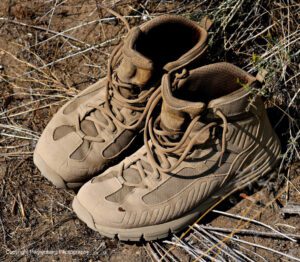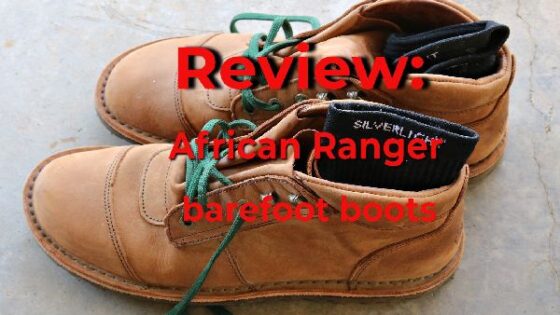Choosing a pair of hiking boots or shoes can a daunting task. But after all your research and shopping, the footwear will still be really uncomfortable if you go out hiking without breaking them in.
What is the quickest, most effective way to break in new shoes or boots? Here are some tips.
by Leon Pantenburg
From the School of Hard Knocks curriculum:
Don’t do this.
Flashback: I spent the month of August, 1977 hiking in the Beartooth Mountains of Montana and Yellowstone National Park. I started out hiking in a pair of Georgia™ brand logger boots that had seen a lot of hard use the year before. The Georgias served me well, but the sole separated from one boot as we were hiking out of the Beartooths.

Choose the footwear appropriate for the environment. My footwear: flip-flops, running shoes, Merrill walking shoes, Danner day hikers, Cabellas Outfitters and Sorel snow boots. One of these pairs of shoes will take care of my needs.
Heading for Yellowstone in two days, I couldn’t get the boot repaired in Billings on such short notice. So much against my better judgement, I bought a pair of full grain leather Lowa™ hikers to wear. Breaking in started immediately. I put on the boots and the socks I would wear and waded in the creek outside the store until they were completely soaked. Then I walked until they were dry.
A day or so later when I was dropped off at the east entrance to Yellowstone, the boots were still stiff and uncomfortable. For the next 14 days, I hiked the Thorofare Creek and South Loop. I wore the Lowas until my feet started getting sore, then switched to my Adidas running shoes. I was wading creeks every day, so I would put on the running shoes to cross. Much of the time, I ended up hiking in wet running shoes.
On my last day in Yellowstone, I walked to the Old Faithful Inn in a snowstorm, wearing my soggy Adidas. The moral of the story: Don’t even think about breaking-in boots during a hiking trip and take along a backup pair of footwear. (Excerpt from Bushcraft Basics: A Common Sense Wilderness Survival Handbook.)

These leather hikers were designed for carrying heavy packs over rough terrain. They were tough to break in.
There are many ways to break in boots. Probably the most common, and the one I use most, is to just start wearing the boots with the socks you will wear. I walk a couple miles every night with my Lab, rain or shine, and my shoes get quickly broken in. But it takes some mileage, and I’ve found that a minimum of about 20 miles is needed to just start breaking in boots. If you have the time, this method is your best bet.
But suppose that despite your best intentions of being prepared, you don’t have a lot of time to break in your boots or shoes. What then? Here are five tips for breaking in new hiking footwear.
First: Get the right footwear for the situation and environment. You don’t want heavy, insulated leather boots for summer wear in southeastern swamps, nor should you get non-waterproof, mesh uppers for use in snow. (Here is how to decide what boots will work best for you.)
Generally speaking, the stouter and more sturdy the boot, the longer it will take to break in. When I worked in a grocery store, my job entailed walking all day. At work, I’d start wearing the new boots, and would switch them out before my feet got sore. It didn’t take long for the new boots to become comfortable.
Wade and walk: This method was mentioned by my dad, a World War II infantry officer with Patton’s Third Army. His company would all get issued new boots, and they had to break them in quickly. The quick way was to wade in a creek, get the boots wet and walk in them until they dried. This method can work pretty well. But beware – hiking in wet boots and soggy socks is an invitation for blisters and sore feet. I don’t use this method if there is any other choice.
Wet and walk: Fill the boots with water, or soak them in a bucket of water. Dry the boots thoroughly with a towel, then put on dry socks and go for a walk. As the socks start to get soggy, change them out with a fresh pair of dry socks. Keep walking and changing socks until the boots are completely dry.

These Danner Fullbore Coyote Hot hikers were broken in on dog walks and by hiking in the Oregon high desert.
Loosen the leather with a treatment. I use mink oil or Obernauf’s Leather Treatment. Daub the leather between the toe and heel with the conditioner and work it in. You might also massage in some on the instep between the laces and sole. This doesn’t replace wearing the shoes, but it may help or hasten the break-in process.
Ice ’em down. This can help if the boot is tight on the instep and needs some widening. Fill a bread sack or other plastic bag with water, and put it in the boot. Place the boot in the freezer, toe down, heel up. The expansion of the water as it freezes will stretch the boot. I’ve used this method with some hikers that stubbornly resisted other methods.
There are a lot of factors that determine how comfortable your hiking footwear will be. Consider these things when you are shopping:
- Shoes or boots for hiking?
- Waterproof or not?
- What are the best socks for the conditions?
- How do you avoid getting sore feet?
- Will the shoes or boots keep your feet warm?
When it comes to gear, don’t scrimp on your sleeping bag, clothing or footwear. But regardless of the footwear you choose, make sure those boots or shoes are well broken-in. It can be the difference between a fun outing or a miserable, painful outdoor experience.
FEEDBACK and COMMENTS:
From Gus: Great post! I was infantry for 6 years and we were told to stand in the shower with our new boots then carry out all of our garrison duties until they dried. It definitely helped but nothing breaks them in like walking!
Please click here to check out and subscribe to the SurvivalCommonSense.com YouTube channel – thanks!






Leave a Reply